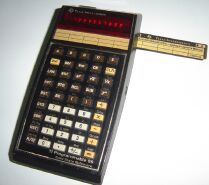TI-59

A TI-59 showing one card in the holder on the front of the calculator and another being inserted into the card reader in the side.
|
|
| Type | Programmable |
|---|---|
| Manufacturer | Texas Instruments |
| Introduced | May 1977 |
| Discontinued | 1983 |
| Cost | US$300 |
| Calculator | |
| Entry mode | Infix |
| Precision | 13 |
| Display type | Light-emitting diode |
| Display size | 10 digits |
| CPU | |
| Processor | TMC0501 |
| Programming | |
| Programming language(s) | key stroke (Turing-complete) |
| Memory register | 100 |
| Program steps | 960 |
| Other | |
| Weight | 240 grams |
| Dimensions | 16.3x7.3x3.6 cm |

The TI-58C
|
|
| Type | Programmable |
|---|---|
| Manufacturer | Texas Instruments |
| Introduced | May 1977 |
| Discontinued | 1983 |
| Cost | US$125 |
| Calculator | |
| Entry mode | Infix |
| Precision | 13 |
| Display type | Light-emitting diode |
| Display size | 10 digits |
| Programming | |
| Memory register | 60 |
| Program steps | 480 |
| Other | |
| Weight | 240 grams |
| Dimensions | 16.3x7.3x3.6 cm |
The TI-59 is an early programmable calculator, that was manufactured by Texas Instruments from 1977. It is the successor to the TI SR-52, quadrupling the number of "program steps" of storage, and adding "ROM Program Modules" (an insertable ROM chip, capable of holding 5000 program steps). Just like the SR-52, it has a magnetic card reader for external storage. One quarter of the memory is stored on each side of one card. It was one of the first LED calculators with the capability and flexibility to take on many real-world calculation challenges, and quickly became popular with professionals in many fields.
The TI-58 (May 1977), and later TI-58C (1979), are cut down versions of the TI-59, lacking the magnetic card reader and having half the memory, but otherwise identical. Although the TI-58C uses a different chip than the TI-58, the technical data remain identical. The "C" in a TI (or HP) model name indicates that the calculator has a constant memory (or continuous memory, respectively) allowing retention of programs and data when turned off.
These calculators use a parenthesized infix calculation system called "Algebraic Operating System" (AOS), where, compared to the postfix RPN system used by other scientific calculators (such as Hewlett-Packard), the operator enters calculations just as they are written on paper, using up to 9 levels of parenthesis.
The calculator can be powered from an external adapter or from internal NiCd rechargeable battery pack (although the battery has to remain present when using the external AC adapter to avoid damage to the calculator circuitry).
 The red LED display showed 10 decimal digits of precision.
The red LED display showed 10 decimal digits of precision.
Programming simple problems with the TI-59 or TI-58 is a very straightforward process. In programming mode, the TI-59 simply records key presses. Alphabetical keys provide easy access to up to ten entry points. It is also possible to activate any of the programs in the pre-programmed memory module, and run one like any user-written program. Programs written by the user can also use programs in the module as subroutines. The module's programs run directly from ROM, so they leave the calculator's memory free for the user.
...
Wikipedia
